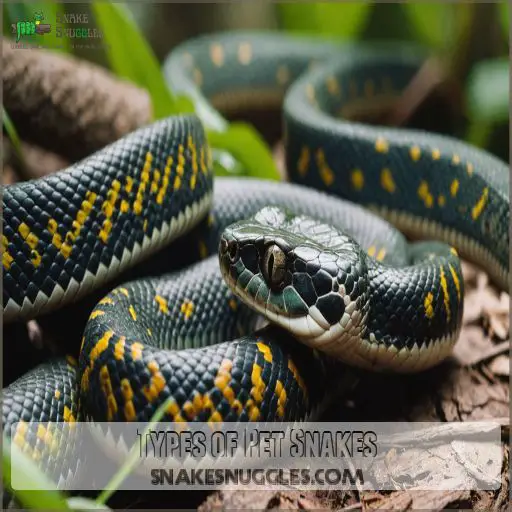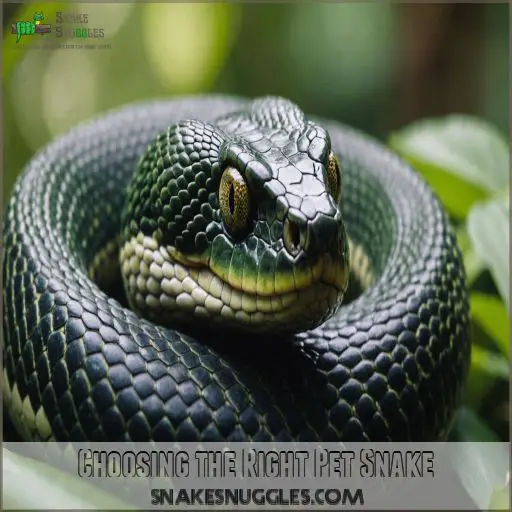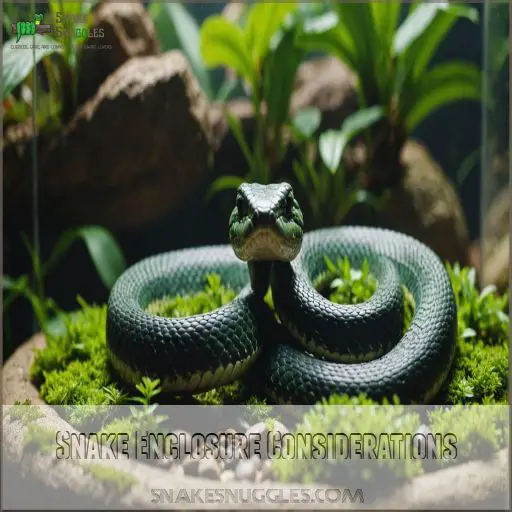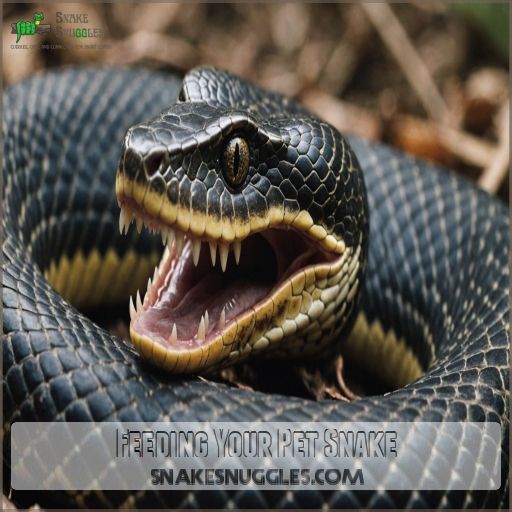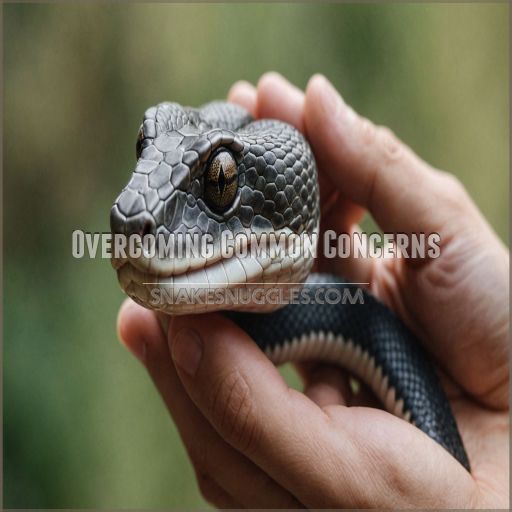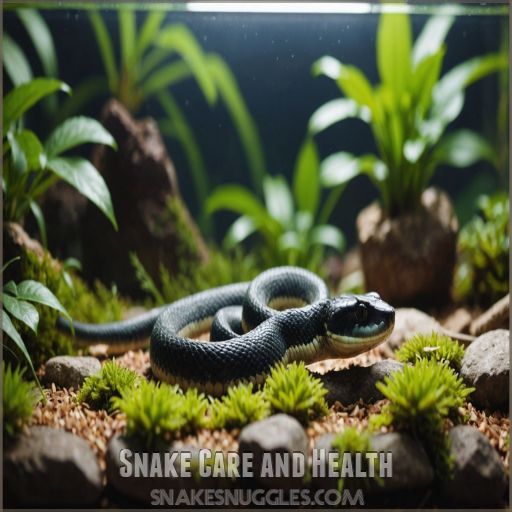This site is supported by our readers. We may earn a commission, at no cost to you, if you purchase through links.
 Wondering if snakes make good pets? You’re not alone! These slithery companions can be fantastic for the right owner. They’re low-maintenance, quiet, and don’t need daily walks – perfect for busy apartment dwellers.
Wondering if snakes make good pets? You’re not alone! These slithery companions can be fantastic for the right owner. They’re low-maintenance, quiet, and don’t need daily walks – perfect for busy apartment dwellers.
Most snakes are surprisingly docile and can even enjoy gentle handling. However, they’re not your typical cuddle buddies. You’ll need to be comfortable with their unique care needs, like maintaining proper enclosure temperatures and feeding them whole prey (mice, anyone?).
While they might not wag their tails when you come home, snakes offer a fascinating glimpse into the reptile world, especially when you learn about their unique ability to brumate bruminate like snakes. Just remember, these escape artists require secure habitats to prevent any Houdini-like disappearing acts.
Table Of Contents
- Key Takeaways
- Snakes as Pets: Pros and Cons
- Types of Pet Snakes
- Choosing the Right Pet Snake
- Snake Enclosure Considerations
- Feeding Your Pet Snake
- The Benefits of Owning a Snake
- Overcoming Common Concerns
- Snake Ownership for Beginners
- Snake Care and Health
- Building a Strong Bond With Your Snake
- Frequently Asked Questions (FAQs)
- Are snakes good pets for beginners?
- What types of snakes can be kept as pets?
- Should you buy a snake as a pet?
- What makes a snake a good pet?
- Are pet snakes friendly?
- What is the friendliest snake to have as a pet?
- Do snakes bond with their owners?
- Do snakes enjoy being pet?
- How long do pet snakes typically live?
- Are pet snakes safe around children?
- Can pet snakes recognize their owners?
- Do pet snakes require regular veterinary check-ups?
- Can different snake species be housed together?
- Conclusion
Key Takeaways
- You’ll find snakes are low-maintenance pets that don’t need daily walks or constant attention, making them perfect for busy apartment dwellers or those with limited space. Just remember, these escape artists require secure habitats to prevent any Houdini-like disappearing acts!
- While many snakes have a friendly nature and can enjoy gentle handling, you’ll need to be prepared for their unique care needs. This includes maintaining proper enclosure temperatures, feeding them whole prey (hope you’re not squeamish!), and learning to read their subtle body language.
- You’ve got plenty of options when it comes to choosing a pet snake. From docile corn snakes to striking ball pythons, there’s a slithery friend for every lifestyle. Just be sure to do your homework and pick a species that matches your experience level and commitment.
- Owning a snake can be a long-term commitment, with many species living 10-30 years. While they may not cuddle like a furry friend, these scaly companions can bring joy, education, and a touch of the exotic to your life. Just don’t expect them to wag their tails when you come home!
Snakes as Pets: Pros and Cons
Snakes can make fascinating pets with their low maintenance needs and affordable care, but they do have a knack for staging daring escape attempts when you least expect it.
While many snakes are friendly and enjoy handling, you should still be prepared for the occasional bite if your new slithery friend feels threatened.
Low Maintenance Pet Care
Looking for a low-maintenance pet? Snakes might be your perfect match.
Unlike furry friends, these slithery companions don’t need daily walks or constant attention.
You’ll only need to feed them once or twice a week, and their enclosures require cleaning just monthly.
Plus, they’re quiet and odor-free, making them ideal for apartment living.
With snakes, you can enjoy pet ownership without the daily grind of traditional pets.
Snakes Can Be Escape Artists
Snakes often moonlight as escape artists, keeping owners on their toes. You’ll need to be vigilant about securing their enclosure to prevent any Houdini-like disappearing acts.
- Invest in escape-proof enclosures with tight-fitting lids
- Double-check all potential
Friendly Nature and Handling
Contrary to popular belief, many snakes have a friendly nature and enjoy human interaction.
You’ll find that with proper handling techniques, your scaly friend can become quite sociable.
Building trust is key; start with short, gentle sessions and gradually increase handling time.
As you bond, you might be surprised by your snake’s unique personality and the stress relief they can provide.
Potential for Bites and Escapes
Handling your slinky friend can be as smooth as silk, but always remember snake bite prevention and enclosure security. They might be escape artists planning their great escape.
To keep things safe:
- Use escape-proof housing
- Master handling techniques
- Make sure you have safe interaction
- Regularly check enclosure for gaps
- Stay alert and responsible.
Who knew keeping snakes could be such a Houdini act?
Types of Pet Snakes
For pet snakes, some species are better suited for beginners than others.
From the ever-popular corn snake and ball python to the impressive boas and pythons, there’s a slithery companion out there for every snake enthusiast.
Beginner-Friendly Snakes: Corn Snakes and Ball Pythons
Choosing beginner-friendly snakes? Corn snakes and ball pythons make a brilliant start to your reptile journey. Corn snake care is straightforward, with morph varieties to spice up their look. Ball python handling can be a bit like convincing a cat into a bath—tricky. Both need simple enclosure setups and stick to a modest feeding guide, making them great pet snakes.
| Feature | Corn Snake | Ball Python |
|---|---|---|
| Length | 3-5 feet | 3-5 feet |
| Temperament | Docile | Can be hesitant |
| Origin | North America | Central and Western Africa |
| Lifespan | 15-20 years | Up to 30 years |
| Handling Ease | Easy for beginners | Requires patience |
Boas and Pythons: Dumerils Boa and Amazon Tree Boa
Venturing from Corn Snakes, let’s chat boas and pythons! Dumerils Boa, a ground-dweller, demands a roomy home and relishes live meals.
Meanwhile, the Amazon Tree Boa, an arboreal acrobat, thrives in vertical spaces with branches galore.
With distinct care needs, these serpents promise charm and challenge. Whether ground or tree-loving, boas bring unique companionship, always spicing up snake-owner adventures!
Choosing the Right Pet Snake
Choosing the right pet snake is as thrilling as picking the perfect Netflix series—both require a bit of research to make sure you get a great fit.
You’ll want to select a species that matches your interests and level of experience, making sure you have a long, happy roommate relationship with your slithery friend.
Researching the Right Snake Species
Choosing the right snake species is really important. You’ll want to research each snake’s temperament, lifespan, habitat needs, and dietary requirements.
Some snakes are more beginner-friendly, like corn snakes and ball pythons, while others, like the hognose, may be better suited for experienced owners. These snakes are naturally shy and reclusive, preferring a solitary lifestyle with ample hiding places.
Take your time to find the perfect slithery companion!
- Research snake species’ temperaments
- Consider habitat and dietary needs
- Prioritize beginner-friendly options like corn snakes
- Avoid species better suited for experienced owners
Purchasing From Reputable Sources
When you’re eyeing a slithery new friend, the reputation of your snake vendor is as important as a sturdy lid on the enclosure.
Ethical sourcing and price transparency are key to easing your snake ownership decision.
Opt for breeders that offer health guarantees and stellar customer support.
After all, snake happiness starts with that first careful choice!
Health Checks and Care Instructions
After you’ve found your slithery friend from a reputable source, give it a health check—think of this as the snake’s annual physical.
Make sure there’s no Parasite Prevention issue and that the Shedding Process is on schedule.
Get detailed care instructions on Temperature Control, the perfect Diet & Feeding, and Enclosure Setup.
That’s your snake guide to setting up the perfect snake terrarium!
Long-Term Commitment to Snake Care
Now that you’ve got your snake and its care instructions, it’s time to think about the long haul. Owning a snake isn’t just a flash in the pan; it’s a commitment that can span decades. Your scaly friend might outlive your favorite pair of jeans!
- You’ll witness your snake’s unique personality unfold over the years
- Your bond will grow stronger with each successful feeding and handling session
- You’ll become the go-to "snake whisperer" among your friends and family
Snake Enclosure Considerations
Setting up the perfect home for your scaly friend is really important for their health and happiness.
From selecting the right-sized enclosure to maintaining proper temperature and humidity levels, you’ll need to keep a few things in mind to make sure your snake feels safe and comfortable in its new habitat.
Size and Security of the Enclosure
You’ve chosen your perfect pet snake, but now it’s time to set up their home sweet home.
The size of your snake’s enclosure is a big deal – think of it as their personal kingdom.
You’ll want to make sure it’s roomy enough for your scaly friend to stretch out and explore.
But here’s the kicker: it needs to be Fort Knox-level secure to prevent any Houdini-like escape attempts.
Temperature and Humidity Control
Temperature and humidity control is the heart of your snake’s comfort zone.
Like Goldilocks, your slithery friend needs everything just right.
- Invest in quality snake heating pads and thermostats.
- Monitor humidity levels religiously.
- Make sure your enclosure has proper ventilation.
- Consider misting systems for tropical species.
Remember, a happy snake is a healthy snake.
By mastering these elements, you’ll be the coolest snake parent on the block!
Substrate and Decorations for a Comfortable Environment
The right substrate and decor can turn your snake’s enclosure into a cozy oasis.
| Substrate Options | Pros | Cons |
|---|---|---|
| Aspen shavings | Burrowing-friendly | Can mold if wet |
| Coconut husk | Humidity-retaining | Pricier option |
| Newspaper | Easy to clean | Less natural |
Remember, your choice should suit your snake’s species and habits.
Add some branches for climbing and fake plants for a natural feel.
Your scaly friend will thank you!
Hiding Spots and Visual Barriers
After setting up the perfect substrate, it’s time to focus on your snake’s privacy.
Snakes are naturally shy creatures, and providing hiding spots is like giving them their own cozy retreat.
Think of it as creating a snake-sized blanket fort!
Incorporate visual barriers such as branches, rocks, or artificial plants.
These offer security and add a touch of natural beauty to your snake’s home.
Feeding Your Pet Snake
Feeding your pet snake is a really important part of their care, but it doesn’t have to be a tough task.
You’ll need to know the right type and size of prey, how often to feed, and some handy tips to make mealtime stress-free for both you and your scaly friend.
Frequency and Type of Food for Snakes
Feeding snakes isn’t as scary as it seems.
Most snakes eat once or twice a week, depending on their species and size.
Your scaly friend’s menu typically features rodents, but some species prefer insects or fish.
Remember to stick to a consistent feeding schedule and always provide fresh water.
It’s like clockwork – regular meals keep your serpentine pal happy and healthy!
Prey Size and Thawing Frozen Prey
Now that you’ve got your snake’s feeding schedule down, let’s size up their meals.
You’ll want to choose prey that’s about the same width as your snake’s widest part.
Frozen prey’s the way to go, but don’t just toss it in there!
Thaw it out in the fridge overnight, then warm it up to room temperature.
It’s like prepping a tiny, scaly TV dinner!
Handling and Feeding Techniques
Your snake’s feeding time can be a thrilling experience, but it’s really important to handle it safely.
- Use feeding tongs to offer prey
- Feed in a separate enclosure to prevent cage aggression
- Avoid handling your snake for 24-48 hours after feeding
- Never feed live prey to prevent injury to your snake
Remember, patience is key when developing a feeding routine that works for both you and your scaly friend.
Providing a Clean Water Bowl and Regular Cleaning
While caring for your scaly friend, don’t forget the importance of a clean water bowl and regular enclosure maintenance.
Refresh the water daily using a shallow, tip-resistant bowl that’s easy for your snake to access.
Spot-clean the substrate weekly, and give the entire enclosure a thorough scrub-down monthly.
This hygiene routine keeps your pet healthy and makes your snake-keeping experience more enjoyable.
Remember, a tidy home is a happy home—even for reptiles!
The Benefits of Owning a Snake
You might be surprised to learn that snakes can make excellent pets, offering unique benefits that many traditional pets can’t match.
From their low-maintenance care requirements to the stress-reducing effects of watching them gracefully move, owning a snake can be a rewarding and educational experience that brings joy and companionship to your life.
Low Maintenance and Easy to Care For
After mastering snake feeding, you’ll appreciate how low-maintenance these reptiles are.
Snakes don’t need daily walks or constant attention, making them perfect for busy pet owners.
Their care routine is a breeze:
- Weekly feedings (no more forgetting to fill the food bowl!)
- Monthly enclosure cleaning (goodbye, daily litter scooping)
- Occasional shedding assistance (like helping your friend with a tricky zipper)
- Minimal handling required (perfect for introverted pet parents)
These slithery friends fit seamlessly into your lifestyle, giving you more time to binge-watch your favorite shows.
Stress Reduction and Happiness Boost
Snakes aren’t just low-maintenance pets; they’re also secret stress-busters! Studies show that pet ownership can be a real mood-lifter, and snakes are no exception.
Imagine this: you’ve had a rough day, but then you come home to your scaly friend. Their calm presence and unique beauty can help melt away your worries. It’s like having your own personal zen master – just with more scales!
Unique Companionship and Interaction
Beyond stress relief, snakes offer a one-of-a-kind bond.
You’ll discover a fascinating companion with:
- Silent understanding – they’re masters of non-verbal cues
- Zen-like presence – their calm nature can be contagious
- Tactile connection – feeling their smooth scales is oddly soothing
Imagine curling up with a book while your scaly friend lounges nearby. It’s like having your own living, breathing meditation partner. Who knew reptiles could be such chill buddies?
Educational Opportunities and Responsibility
Through snake ownership, you’ll begin a fascinating journey of learning.
You’ll gain insights into reptile biology, behavior, and care, fostering a deeper appreciation for these misunderstood creatures.
Responsible ownership also teaches valuable life skills like commitment and empathy.
As you become an expert in snake care, you might even find yourself educating others, dispelling myths, and contributing to conservation efforts like protecting Kenyan Sand Boas.
It’s a slithery path to personal growth and environmental awareness!
Overcoming Common Concerns
You might be intrigued by the idea of owning a snake, but common concerns like fear, escape risks, and potential bites could be holding you back.
Let’s tackle these worries head-on and explore how you can overcome them to enjoy the unique companionship of a pet snake.
Addressing Fears and Anxieties About Snakes
While it’s natural to feel uneasy about snakes, understanding them can help you overcome your fears.
Let’s debunk some common myths and learn how to safely interact with these fascinating creatures.
- Educate yourself on snake behavior
- Start with gentle, non-venomous species
- Practice proper handling techniques
- Observe their body language for better communication
Remember, most pet snakes are more scared of you than you’re of them!
Understanding and Managing Escape Risks
Now that you’re feeling more comfortable with snakes, let’s tackle a common concern: escapes.
Snakes are curious creatures and natural explorers.
To keep your slithery friend safe, you’ll need to become a master of enclosure security.
Think of it as creating a cozy, escape-proof home.
Secure lids, proper ventilation, and sturdy barrier materials are your best friends.
Remember, a happy snake is a contained snake!
Dealing With Potential Bites and Injuries
Snakes may have a bite worse than their bark, but don’t let that scare you off!
While bites are rare with proper handling, it’s important to know how to prevent and manage them.
- Learn to read your snake’s body language to avoid stressful situations like a relaxed posture
- Keep a first aid kit handy, including antiseptic and bandages
- Know the difference between venomous and non-venomous bites – it could save your life!
Snake Ownership for Beginners
If you’re considering a snake as your first pet reptile, you’re in for a unique and rewarding experience.
Choosing the right species, learning proper care techniques, and connecting with other snake enthusiasts can help make sure a smooth start to your snake-keeping journey.
Evaluating Your Lifestyle and Experience Level
Before bringing a snake home, let’s take a close look at your lifestyle. Are you ready for a scaly sidekick? Here’s a quick checklist to see if you’re snake-ready:
| Factor | Low | Medium | High |
|---|---|---|---|
| Time Commitment | 1-2 hrs/week | 3-4 hrs/week | 5+ hrs/week |
| Space Needs | Small tank | Medium enclosure | Large vivarium |
| Handling Comfort | Nervous | Cautious | Confident |
| Financial Resources | Tight budget | Moderate spending | No constraints |
| Previous Pet Experience | None | Some | Experienced |
Are you ready to take the plunge?
Choosing the Right Snake Species for Beginners
Before you get a snake, you’ll want to think about more than just their cute little faces.
Corn snakes and ball pythons are often recommended for newbies because of their docile nature and manageable size.
These species typically have longer lifespans, so you’re in for a long-term commitment.
Remember, a snake’s temperament can vary, so it’s important to research their specific needs before bringing one home.
Learning Proper Handling and Care Techniques
Now that you’ve chosen your scaly companion, it’s time to master the art of snake wrangling! Don’t worry, it’s not as tricky as wrestling an alligator. Here are four key techniques to keep you and your snake happy:
- The support-and-glide method
- Proper enclosure maintenance
- Safe feeding practices
- Regular health check-ups
Remember, handling your snake is like learning to dance – it takes practice, patience, and a bit of rhythm. You’ll be a snake charmer in no time!
Joining a Snake-Keeping Community for Support
You’ve got the handling basics down, but don’t go it alone!
Joining a snake-keeping community is like finding your scaly soulmates.
Local breeders, online forums, and reptile shows are goldmines for snake care tips.
You’ll slither into a world of knowledge, from feeding tricks to enclosure hacks.
Plus, you’ll make friends who won’t bat an eye when you casually mention your new ball python’s adorable yawn.
Snake Care and Health
Keeping your pet snake healthy and happy requires regular monitoring and care.
You’ll need to watch for signs of illness, maintain proper hygiene, seek vet care when needed, and provide enrichment to keep your scaly friend stimulated.
Monitoring Your Snake’s Health and Hygiene
Keeping your scaly friend healthy isn’t rocket science, but it does require a keen eye. Regular check-ups on your snake’s skin, eyes, and eating habits are key. Think of yourself as a snake detective, always on the lookout for clues.
Keep that enclosure sparkling clean and watch out for any unwanted hitchhikers (aka parasites).
A well-balanced diet is your snake’s ticket to a long, slithery life.
Recognizing Signs of Illness or Injury
As a snake owner, you’re the first line of defense against health issues.
Keep an eye out for signs of trouble, like unusual behavior, loss of appetite, or changes in skin appearance.
Common red flags include respiratory problems, mouth rot, and scale abnormalities.
If your scaly friend seems off, don’t wait to investigate.
Remember, early detection can be a real lifesaver for your serpentine companion!
Seeking Veterinary Care and Advice
Keeping an eye on your snake’s health is really important, but sometimes you need a pro to schedule regular check-ups.
Finding a vet who specializes in exotic pets can be a real lifesaver.
- Research local exotic vets before an emergency
- Schedule annual check-ups for preventative care
- Keep detailed records of your snake’s behavior and health
- Don’t hesitate to seek advice if something seems off
Remember, in terms of snake health, it’s better to be safe than sorry!
Providing Enrichment Activities and Stimulation
You might think snakes are low-maintenance pets, but they need mental stimulation too! Enrichment activities keep your scaly friend happy and healthy. Here’s a quick guide to spice up your snake’s life:
| Activity | Purpose |
|---|---|
| Climbing branches | Exercise and exploration |
| Puzzle feeders | Mental challenge |
| Hideouts | Security and comfort |
| Texture variety | Sensory stimulation |
| Scent trails | Hunting instinct activation |
Try these out and watch your snake’s personality shine!
Building a Strong Bond With Your Snake
You might be surprised to learn that snakes can form strong bonds with their owners.
By understanding your snake’s behavior and providing a comfortable environment, you can develop a unique and rewarding relationship with your scaly friend.
Understanding Snake Behavior and Body Language
Curiosity about your snake’s behavior can lead to a deeper bond.
Snakes communicate through subtle body language cues.
Watch for defensive postures like coiling or hissing, which signal discomfort.
Relaxed, smooth movements indicate contentment.
Your scaly friend might even show recognition by flicking its tongue when you approach.
Understanding these silent signals helps you become a snake whisperer, interpreting their mood without a single "hiss-understanding.
Establishing Trust and Handling Techniques
Patience is the secret sauce when establishing trust with your snake.
By consistently handling your scaly friend, you’ll build a strong bond.
- Start with short, gentle handling sessions
- Observe your snake’s body language for signs of stress
- Support its entire body during handling
- Use slow, deliberate movements to avoid startling it
Remember, every snake is unique, so tailor your approach to your pet’s personality.
Providing a Comfortable and Secure Environment
As your snake slithers into its new home, creating a comfortable and secure environment is key to building trust.
Think of the enclosure as your serpentine friend’s personal oasis.
Provide ample hiding spots, choose the right substrate, and maintain proper humidity levels.
It’s like crafting the perfect spa day for your scaly companion!
Remember, a happy snake is more likely to bond with you.
Enjoying the Unique Companionship of Your Pet Snake
With your snake comfortably settled, it’s time to build a unique bond. You’ll discover your scaly friend has a personality all its own.
Regular, gentle handling helps your snake feel at ease with you.
Try offering enrichment activities like new textures or climbing opportunities.
Watch for subtle cues in your snake’s body language – it’s their way of communicating.
Before you know it, you’ll be decoding your serpent’s secret language!
Frequently Asked Questions (FAQs)
Are snakes good pets for beginners?
You’re jumping into the deep end! Snakes can be good beginner pets if you’re ready to learn.
They’re low-maintenance, quiet, and fascinating.
Start with docile species like corn snakes or ball pythons, which have impressive binocular vision.
You’ll need proper research and commitment.
What types of snakes can be kept as pets?
You’ve got plenty of options!
From docile corn snakes to striking ball pythons, there’s a slithery friend for everyone.
Don’t forget about the quirky hognose or the colorful milk snake.
Just pick one that fits your lifestyle!
Should you buy a snake as a pet?
Consider your lifestyle and preferences before getting a snake.
They’re low-maintenance pets, but require specialized care.
If you’re comfortable with their unique needs and feeding habits, a snake can be a fascinating, long-term companion.
Do your homework first!
What makes a snake a good pet?
Did you know 5% of American households own reptiles?
Snakes make great pets because they’re low-maintenance, quiet, and don’t need daily walks.
They’re perfect for busy folks or those with limited space.
Plus, they’re fascinating conversation starters!
Are pet snakes friendly?
Many pet snakes are friendly and docile, especially when handled regularly.
They won’t cuddle like a puppy, but they’ll tolerate gentle interaction.
Remember, each snake has its own personality – some might be more social than others!
What is the friendliest snake to have as a pet?
Picture a gentle soul in scales.
You’ll find the corn snake to be your friendliest serpentine companion.
They’re docile, easy to handle, and rarely bite.
With proper care, these charming reptiles can become your loyal, low-maintenance buddies for years.
Do snakes bond with their owners?
You’ll find snakes don’t bond like mammals do.
They can recognize you and become comfortable with handling, but it’s more about familiarity than affection.
Think of it as mutual respect rather than cuddles and kisses!
Do snakes enjoy being pet?
Snakes don’t crave petting like cats or dogs.
They’re more tolerant than affectionate.
While some may seem to enjoy gentle handling, it’s likely they’re just feeling secure.
Remember, each snake’s personality is unique!
How long do pet snakes typically live?
Like a coiled spring of time, pet snakes can unwind their lives over decades.
You’re looking at 10-30 years of slithery companionship, depending on the species.
That’s a long-term commitment, so don’t let it slip by!
Are pet snakes safe around children?
While pet snakes can be safe around children, it’s important to supervise interactions.
Teach kids proper handling techniques and respect for the animal.
Some species are more docile than others, so choose wisely for a family-friendly slithering companion.
Can pet snakes recognize their owners?
As slippery as this question may seem, your scaly friend isn’t likely to pick you out of a lineup.
Pet snakes can’t recognize specific owners, but they may become familiar with your scent and handling routine over time.
Do pet snakes require regular veterinary check-ups?
You’ll want to schedule yearly check-ups for your scaly friend.
Vets can spot hidden health issues, check for parasites, and make sure your snake’s living its best life.
It’s a slithery investment in their long-term happiness!
Can different snake species be housed together?
Picture a snake salad – not appetizing!
It’s best to keep different snake species apart.
They’ve got unique needs and might not play nice together.
Stick to solo living for your scaly friends to avoid potential reptile rumbles.
Conclusion
Like the snake shedding its skin, your journey into reptile ownership can be transformative.
Do snakes make good pets? For the right person, absolutely! They offer a unique, low-maintenance companionship that’s both fascinating and rewarding.
Remember, responsible snake care involves proper research, a secure habitat, and a long-term commitment.
While they may not cuddle like a furry friend, these scaly companions can bring joy, education, and a touch of the exotic to your life. Embrace the adventure – your perfect serpentine sidekick might be waiting!


